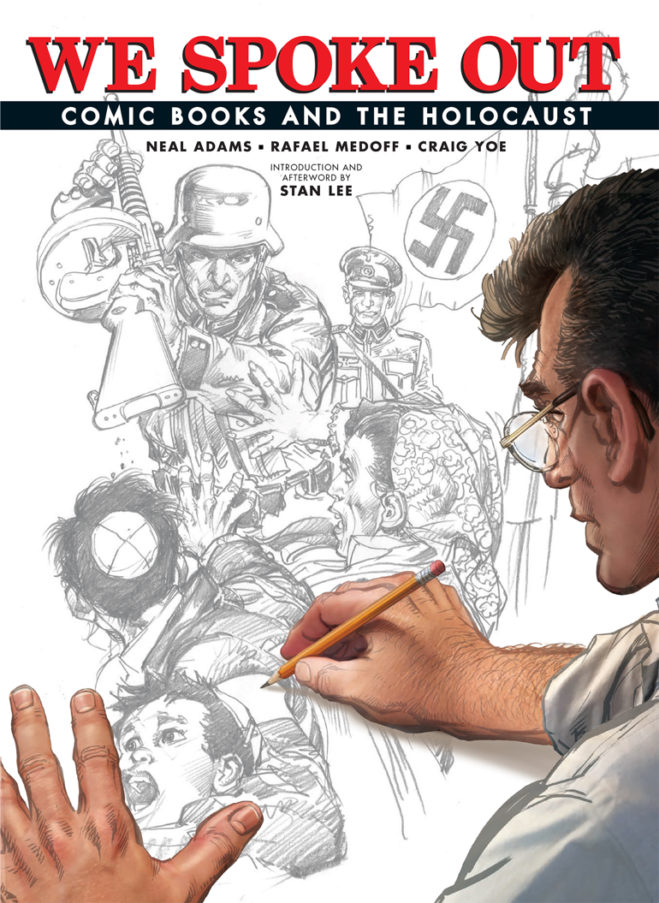Comics are often seen as cheap entertainment. However, there was a time when comics were taking an educational role, especially about genocide and massacre. Before the Holocaust became a topic in school, or before there were museums dedicated to this genocide, people learned about the Holocaust from comics. Comics have long been considered as media that can disrupt conventional ways of seeing war, massacre, and genocide. Comics are weapons to represent the personal impact of war and conflict on individuals and communities.
Here we collect five comics and graphic narratives that tell about genocide and massacres:
1. The 1960s – 1970s Comics on Holocaust-related themes

“Master Race” By Bernard Krigstein, 1955, Reprinted In We Spoke Out. Art By B. Krigstein, Courtesy Yoe Books//Idw. https://www.forbes.com/
When the topic of genocide is still taboo to discuss, the large Jewish comic book industry introduced readers to the Nazi’s atrocities. They created superheroes comics such as 1969’s Captain Marvel, 1971’s Batman and Robin, 1976’s Blitzkrieg (DC Comics), and 1973-1975’s War is Hell (Marvel Comics). The first comic book that directly discussed the Holocaust and mentioned Jews as victims of Nazi persecution was Desert Fox (1951). Comics with Holocaust themes followed later, usually combinimg science fiction and horror, representing Nazis as villains and mentioning Jews as survivors. In 2018, a book entitled We Spoke Out: Comic Books and the Holocaust by comic artist Neal Adams, Holocaust scholar Rafael Medoff and comics historian Craig Yoe gathered 18 stories of classic comic books about the Holocaust from the 1950s until the 1980s into a single collection.
2. Maus (1980 -1991)
Maus by Art Spiegelman
https://en.wikipedia.org/wiki/Maus
Maus was created by Art Spiegelman, an American Cartoonist. It is based on Spiegelman’s interview with his father about his experiences as a Polish Jew and Holocaust survivor. In this graphic novel, Jews were represented as mice, Germans as cats, and Poles as pigs. This book is the only graphic novel that wins a Pulitzer Prize.
3. Bitter Root on Tulsa Massacre
Bitter Root Volume 1
https://www.amazon.com/Bitter-Root-1-Family-Business/dp/1534312129
Bitter Root by David F. Walker, Chuck Brown, and Sanford Greene, is an award-winning comic book series about the 1921 Tulsa Race Massacre and the all-Black towns of early Oklahoma. It tells about the fight of the Sangerye family who specialized in curing the souls of those infected by hate, with a new breed of monster that is loose on the streets of Harlem. This series is in development for a film, directed by Academy Award Winner, Regina King.
Panel discussion on ‘Bitter Root’ comic to commemorate the centennial of Tulsa Race Massacre
Another comic related to the Tulsa Massacre is written by Natalie Chang, for the Watchmen series on HBO. This comic can be accessed online on https://www.theatlantic.com/sponsored/hbo-2019/the-massacre-of-black-wall-street/3217/ Watchmen is a series based on the 1986 DC Comics series of the same title, created by Alan Moore and Dave Gibbons.
4. 99 Days on the 1994 Rwandan Genocide
99 Days (2011), Matteo Casali and Kristian Donaldson, DC Comics.
https://www.dccomics.com/graphic-novels/vertigo-crime-2008/99-days
99 Days was written by Matteo Casali and illustrated by Kristian Donaldson. This graphic narrative blends the American detective noir genre with the 1994 Rwandan genocide as a background story. 99 Days is the story of Antoine Boshoso Davis, a rookie homicide detective for the LAPD. Twelve years ago, he was a young Hutu in Rwanda, who commits to murdering scores of men, women, and children with a machete. Antoine then fled Rwanda for LA, where he grew into a quiet, sensitive man with a deep need for justice – so he joined the LAPD.
5. Safe Area Goražde on the Bosnian War
Safe Area Goražde by Joe Sacco.
https://en.wikipedia.org/wiki/Safe_Area_Gora%C5%BEde
Safe Area Goražde was written and illustrated by Joe Sacco. This journalistic comic book was published in 2000. It describes the author’s experiences during four months in Bosnia in 1995–96. This book is based on conversations with Bosniaks trapped in the enclave of Goražde.

